Archaeological and Epigraphic Remains In Arabic
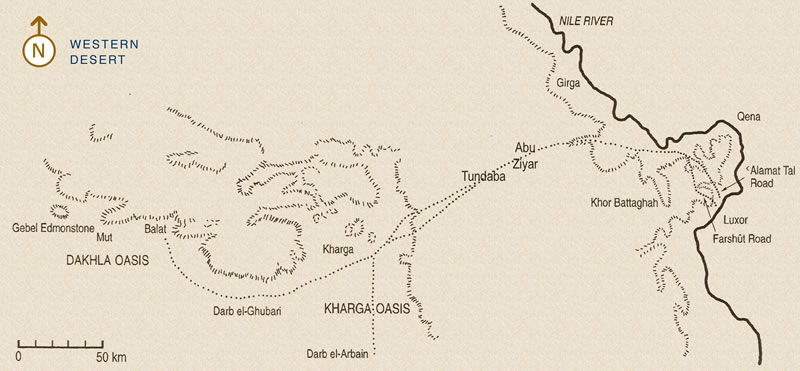
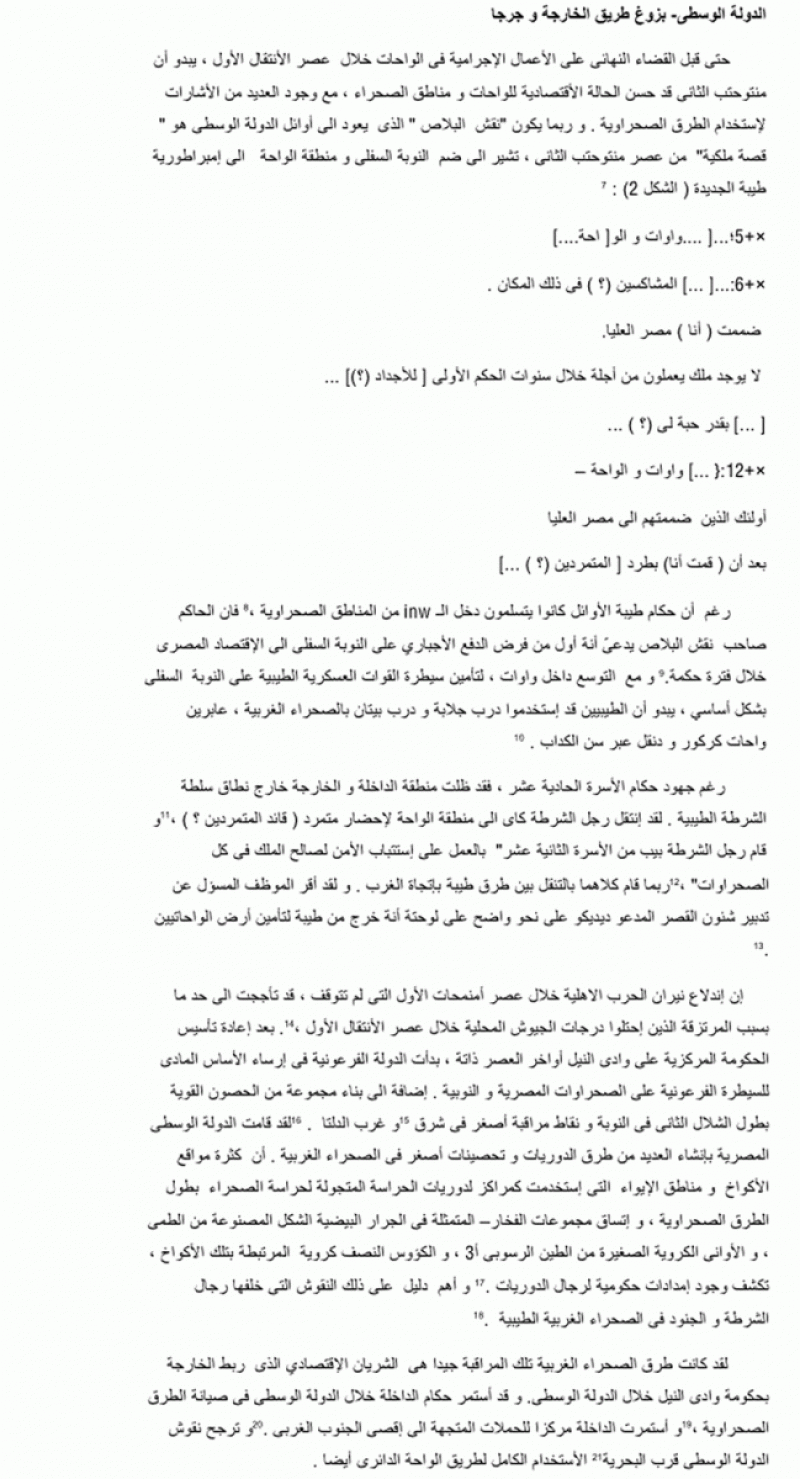
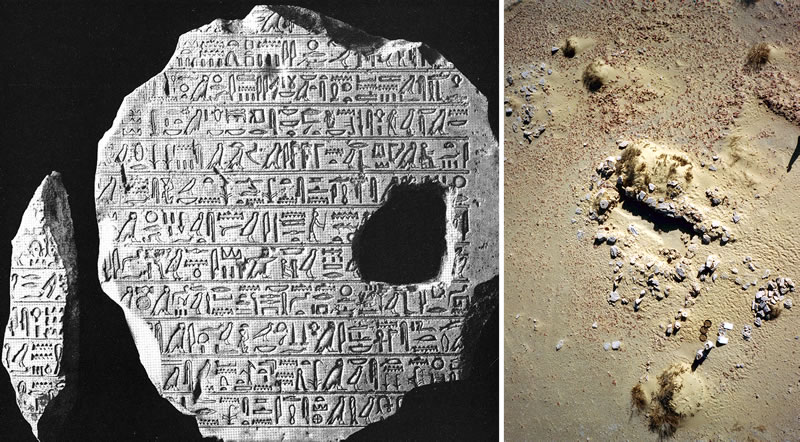

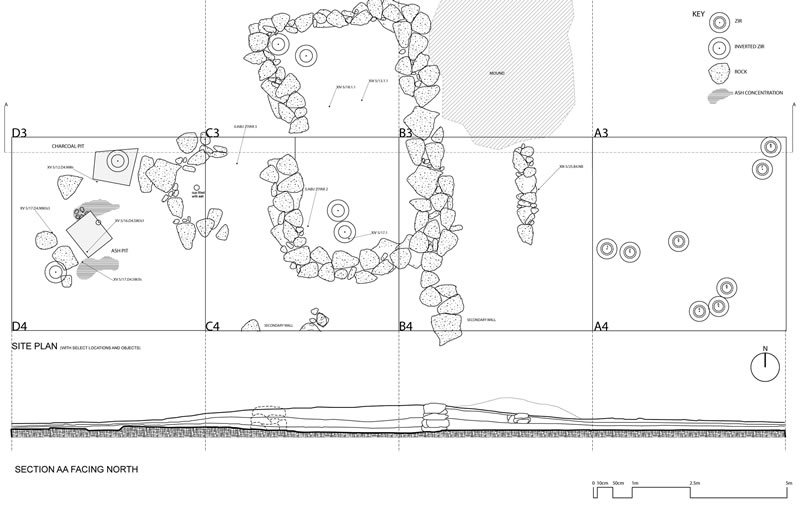
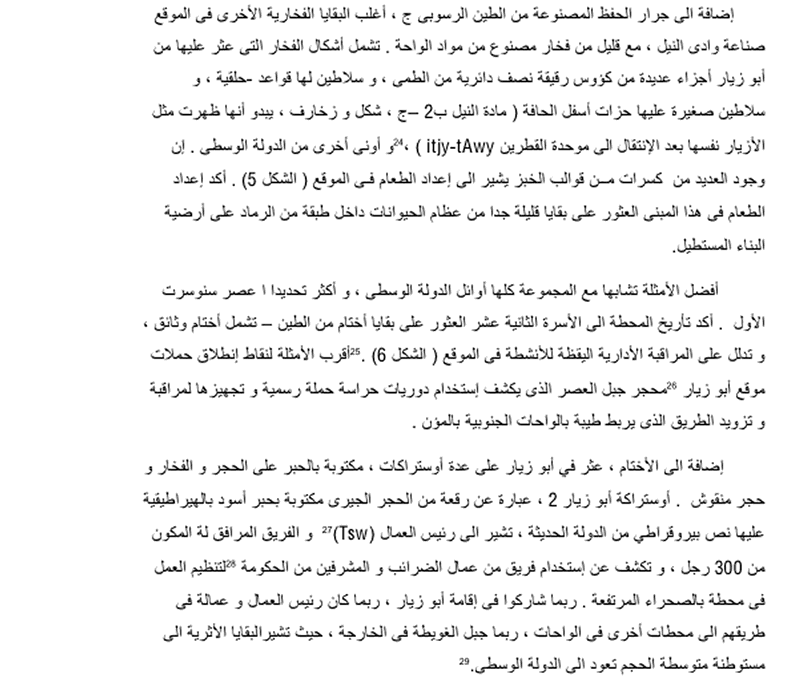
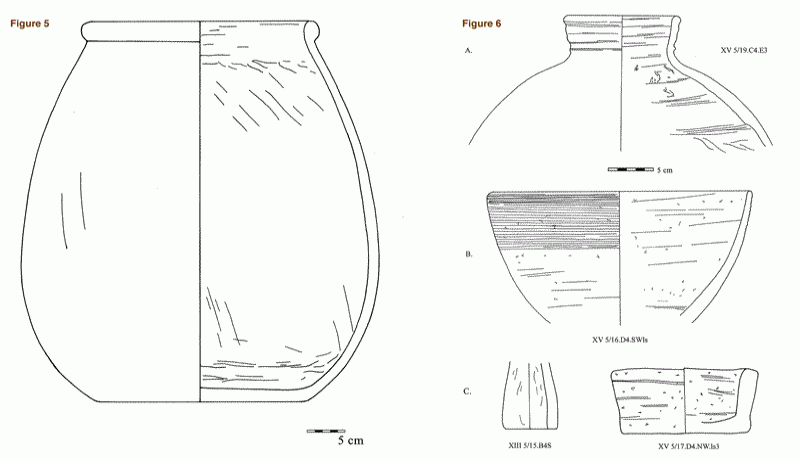

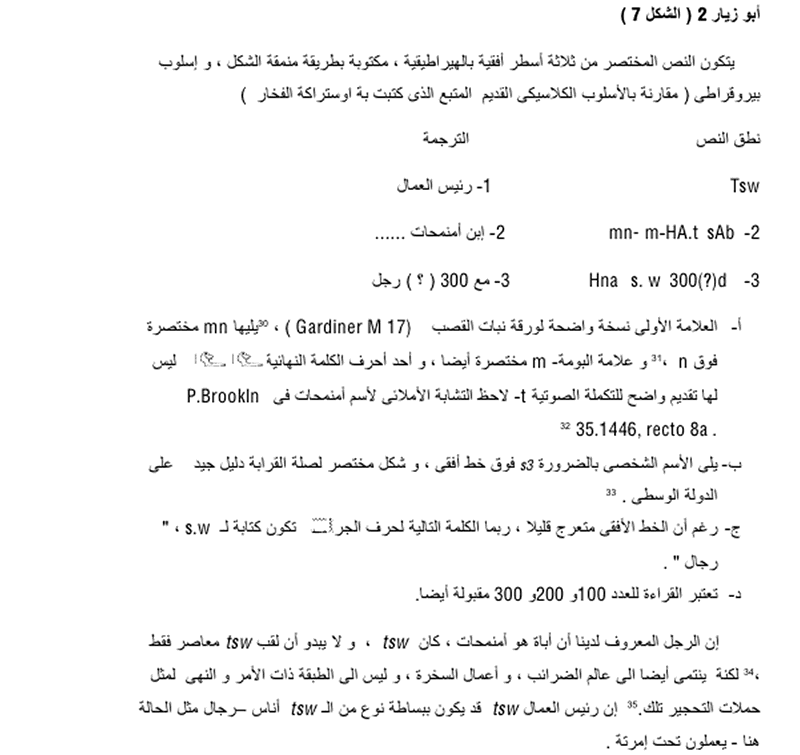

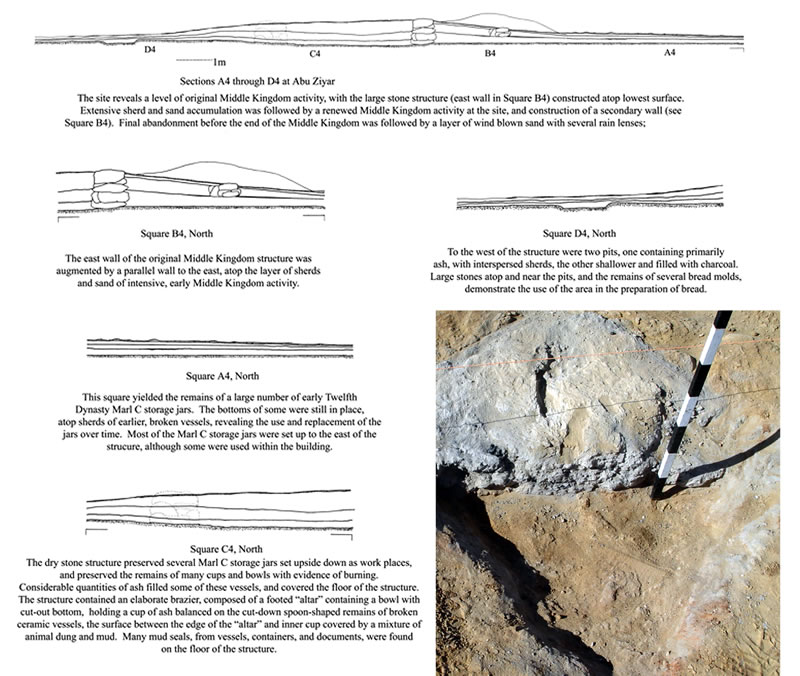

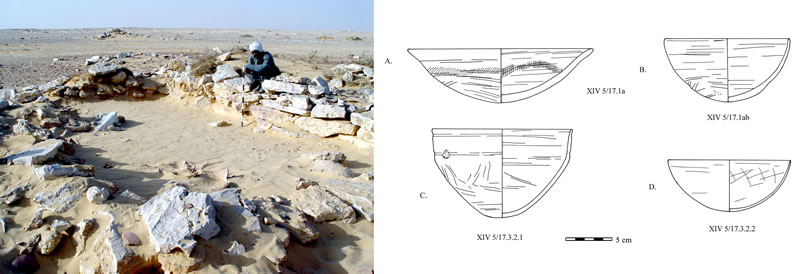
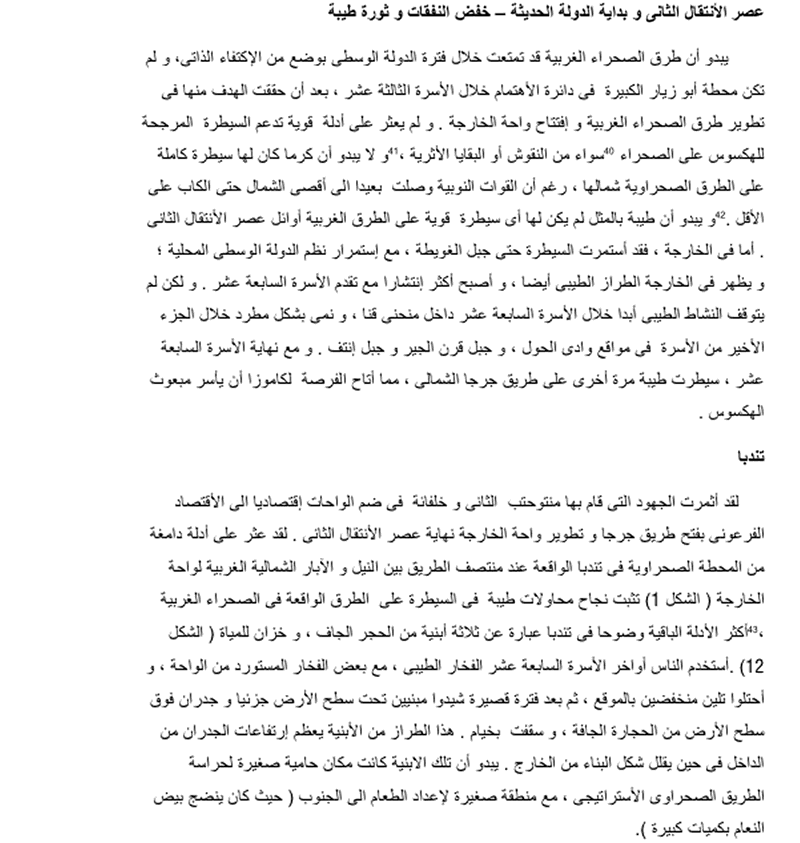
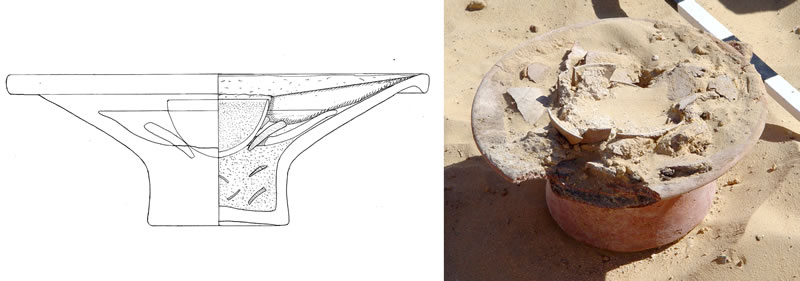
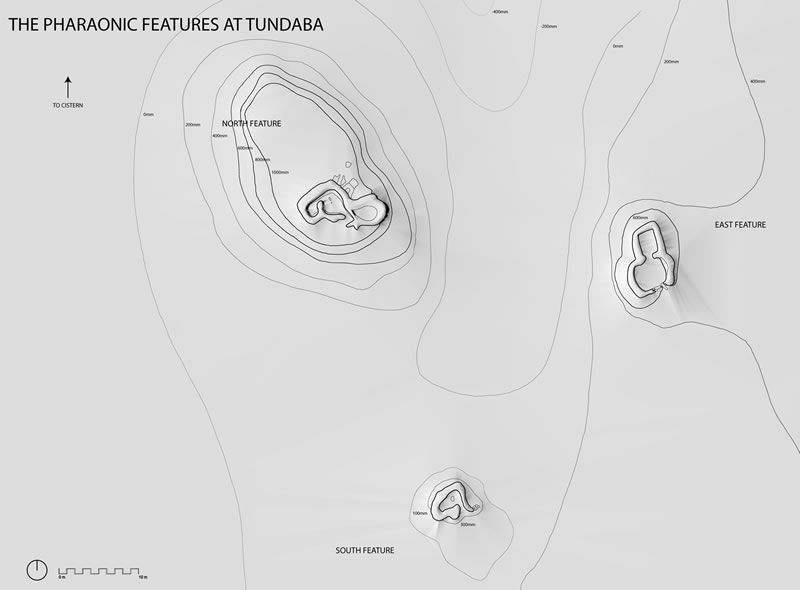
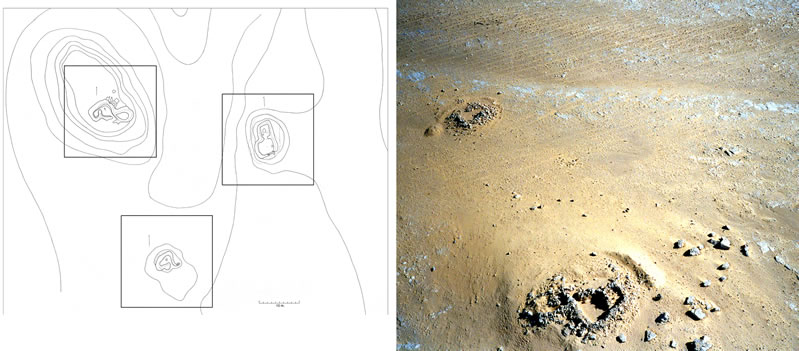
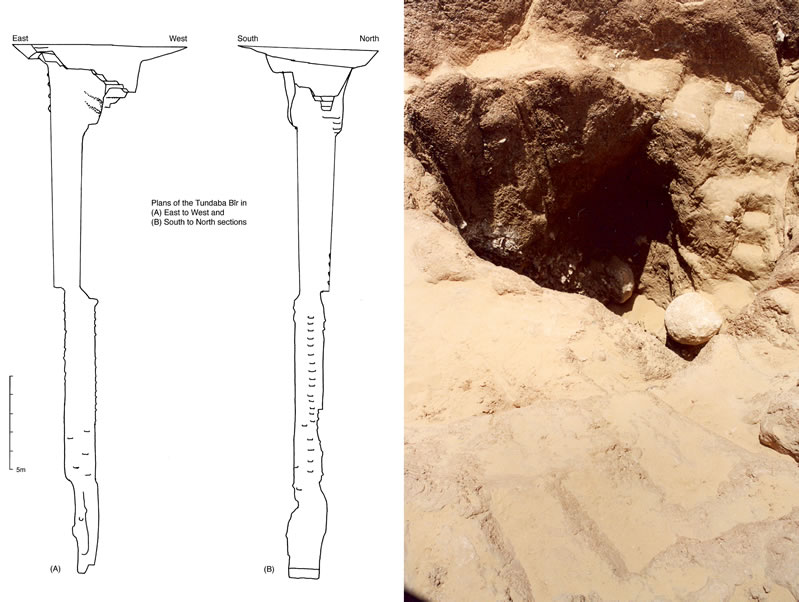

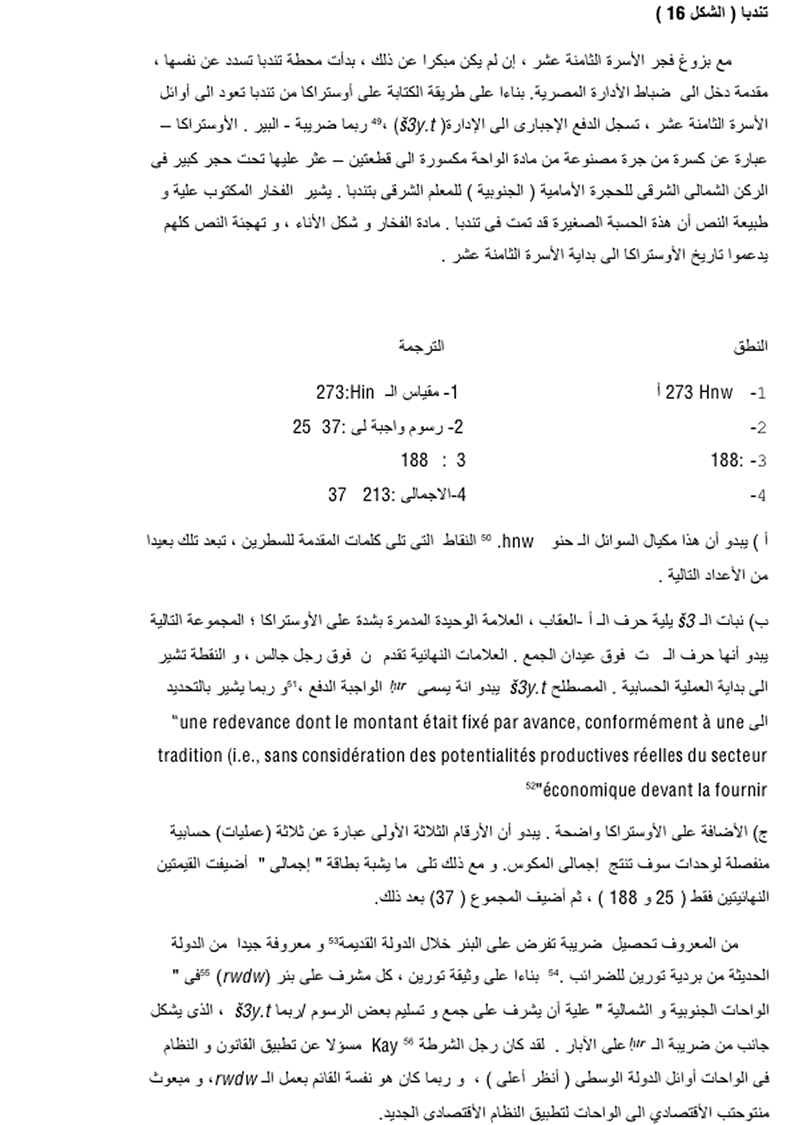



Notes
- 1. A preliminary presentation of the work at Abu Ziyar and Tundaba, based in part on season reports by J.C. Darnell and D. Darnell. An update and expansion of the section on the Abu Ziyar ceramics will appear once D. Darnell has had an opportunity to examine the ceramic remains from the most recent period of work at the site.
- 2. J.C. Darnell, et al., The Theban Desert Road Survey I: The Rock Inscriptions of Gebel Tjauti in the Theban Western Desert, Part 1, and the Rock Inscriptions of the Wadi el Hôl, Part 1, OIP 119 (Chicago, 2002), pp. 35-36; idem., “Opening the Narrow Doors of the Desert: Discoveries of the Theban Desert Road Survey,” R. Friedman, ed., Egypt and Nubia — Gifts of the Desert (London, 2002), pp. 132-155.
- 3. J. C. Darnell, Theban Desert Road Survey I, pp. 30-37.
- 4. On whom see H.G. Fischer, “The Nubian Mercenaries of Gebelein during the First Intermediate Period’, Kush, 9 (1961): 44-80.
- 5. For these concepts see B.H. Liddel Hart, Strategy, 2nd ed. (New York, 1991).
- 6. J.C. Darnell, et al., Theban Desert Road Survey I, pp. 28-29 and 43-46; idem., in Friedman, ed., Egypt and Nubia, pp. 147-149; D. Darnell, in ibid., pp. 165-169.
- 7. H.G. Fischer, Inscriptions from the Coptite Nome, Dynasties VI-XI, Analecta Orientalia 40 (Rome, 1964), pp. 112-113; J.C. Darnell, The Birth of Victorious Thebes, forthcoming.
- 8. A.M. Blackman, “The Stela of Thethi, Brit. Mus. No. 614,” JEA 17 (1931): 55-61 and pl. 8, l. 6; J.J. Clère and J. Vandier, Textes de la première période intermédiaire et de la Xième Dynastie (Brussels, 1948), p. 15.
- 9. E. Bleiberg, “The Redistributive Economy in New Kingdom Egypt: An Examination of B3kw(t),” JARCE (1988): 25; J.C. Moreno Garcia, “Acquisition de serfs durant la première période intermédiare,” RdE, 51 (2000): 129-130 n. 41; S.T. Smith, Wretched Kush (London, 2003), pp. 182-183.
- 10. J.C. Darnell, “The Route of Eleventh Dynasty Expansion into Nubia, an Interpretation Based on the Rock Inscriptions of Tjehemau at Abisko,” ZÄS 131 (2004): 23-37; compare also the title in a rock inscription at Kumma: “prince and count of the (narrow) door (of the desert) of Upper Egypt, of Thebes and Nubia” — G.A. Reisner, D. Dunham, and J.M.A. Janssen, Semna Kumma (Boston, 1960), pl. 100G and p. 156; W.A. Ward, Index of Egyptian Administrative and Religious Titles of the Middle Kingdom (Beirut, 1982), p. 101, no. 844a.
- 11. R. Anthes, “Eine Polizeistreife des Mittleren Reiches in die westliche Oase,” ZÄS 65 (1930): pl. 7, ll. 4-6; R.E. Freed, “Stela Workshops of Early Dynasty 12,” in P. Manuelian (ed.), Studies in Honor of William Kelly Simpson 1 (Boston, 1996), p. 304.
- 12. P.A.A. Boeser, Beschreibung der aegyptischen Sammlung der Niderlandischen Reichsmuseum der Altertümer in Leiden II part 1, Stelen (The Hague, 1909), p. 5 and pl. 10, ll. 7-8; G. Andreu, “Les titres de policiers formés sur la racine schena,” CRIPEL 9 (1987): 19-20.
- 13. H. Schäfer, “Ein Zug nach der grossen Oase unter Sesostris I,” ZÄS 42 (1905): 124-28.
- 14. J.C. Darnell, “The Rock Inscriptions of Tjehemau at Abisko,” ZÄS 130 (2003): 31-48; idem, ZÄS 131 (2004): 23-37.
- 15. S. Quirke, “Frontier or Border? The Northeast Delta in Middle Kingdom Texts,” in The Archaeology, Geography and History of the Egyptian Delta in Pharaonic Times (Oxford, 1989), pp. 261-274.
- 16. A. Fakhry, “Wâdi-el-Natrûn,” ASAE 40 (1940): 837-848.
- 17. J.C. Darnell and D. Darnell, “Theban Desert Road Survey,” in Oriental Institute Annual Report 1996-1997 (Chicago, 1997), pp. 72-73; cf. M. Chartier-Raymond, et al., “Les Sites miniers pharaoniques du Sud-Sinaï, Quelques notes et observations de terrain,” CRIPEL 16 (1994): 61-64; D. Dunham, ed., Second Cataract Forts II: Uronarti, Shalfak, Mirgissa (Boston, 1967), pp. 141-142.
- 18. J. C. Darnell, et al., Theban Desert Road Survey I, pp. 56-65, 70, 73-74, 123-124, 137-138, 141, and 143; idem., in Freidman, ed., Egypt and Nubia, p. 145.
- 19. M. Baud, F. Colin, and P. Tallet, “Les gouverneurs de l’oasis de Dakhla au Moyen Empire,” BIFAO 99 (1999): 1-19; for Middle Kingdom use of the Darb el-Ghubari between Dakhla and Kharga, see J. Osing, “Notizen zu den Oasen Charga und Dachla,” GM 92 (1986): 81-82; H. Winkler Winkler, Rock-Drawings of Southern Upper Egypt 1 (London, 1938), p. 12 and pl. 8, 1.
- 20. G. Burkard, “An Inscription in the Dakhla Region,” Sahara 9 (1997): 152-153, with corrections in Darnell, et al., Theban Desert Road Survey I, p. 73.
- 21. G. Castel and P. Tallet, “Les inscriptions d’El-Harra, oasis de Bahareya,” BIFAO 101 (2001): 99-136.
- 22. Compare B. Bader, Tell el-Daba XIII. Typologie und Chronologie der Mergel C-Ton Keramik (Vienna, 2001), pp. 155-160.
- 23. Do. Arnold, “The Pottery,” in Di. Arnold, The Pyramid of Senwosret I, South Cemeteries of Lisht 1 (New York, 1988), pp. 112-116.
- 24. Compare Do. Arnold, in Arnold, The Pyramid of Senwosret I, p. 111, fig. 55a, no. 8.
- 25. Compare B. Gratien, “Scellements et contrescellements au Moyen Empire en Nubie, L’apport de Mirgissa,” CRIPEL 22 (2001): 47-69; von Pilgrim, “The Practice of Sealing in the Administration of the First Intermediate period and the Middle Kingdom,” in ibid., pp. 161-172.
- 26. I. Shaw, “The 1997 Survey of the Ancient Quarrying Site of Gebel el-Asr (‘The Chephren Diorite Quarries’) in the Toshka Region,” ASAE 74 (1999): 63-67; idem, and E. Bloxam, “Survey and Excavations at the Ancient Pharaonic Gneiss Quarrying Site of Gebel El-Asr, Lower Nubia,” Sudan and Nubia 3 (1999): 13-20; J.C. Darnell and C. Manassa, Inscribed Material from the Gebel el-Asr Quarries, forthcoming.
- 27. Quirke, Titles and Bureaux, pp. 83 and 102.
- 28. Compare W.K. Simpson, Papyrus Reisner 1 (Boston, 1963), p. 38 et passim.
- 29. D. Darnell, in Freidman, ed., Egypt and Nubia, pp. 172-173.
- 30. Möller, Paläographie 1, p. 27.
- 31. Compare Simpson, Reisner 1, p. 103.
- 32. W.C. Hayes, A Papyrus of the Late Middle Kingdom in the Brooklyn Museum (Brooklyn, 1955), pl. 1.
- 33. See W.K. Simpson, Papyrus Reisner III (Boston, 1969), pp. 12-13; J. C. Darnell, Theban Desert Road Survey 1, p. 71.
- 34. As S. Quirke, Titles and Bureaux of Egypt 1850-1700 BC (London, 2004), pp. 83 and 102, notes, discussing the title ṯsw — “it seems more a transiently held position than a permanent designation for an individual” (ibid., p. 102).
- 35. Compare K.-J. Seyfried, Beiträge zu den Expeditionen des Mittleren Reiches in die Ost- Wüste, HÄB 15 (Hildesheim, 1981), pp. 115-131, 188-219, and 259-269. A ṯsw appears in at least one of the Wadi el-Hudi inscriptions (ibid., p. 77; A.I. Sadek, The Amethyst Mining Inscriptions of Wadi El-Hudi 1: Text [Warminster, 1980], pp. 56 and 74), but in a short inscription that does not clarify his function; like some of the hunters and overseers of hounds, he may have been at the site of some mission other than that of the expeditions.
- 36. Compare the comments on the form in Bader, Mergel C-Ton, pp. 60-62.
- 37. As identified by University of Groningen Palaeobotanist Jeroen van Rooij in the expedition’s magazine in Gurna (June 21, 2006). The dung contained digested botanical remains (no longer specifically identifiable), and small pebbles (+/- 1mm in size), suggesting that the mud portion of the compound was — as one would expect — collected on site, the pebbles being desert wash into the Abu Ziyâr pan.
- 38. See the rather small example in C. von Pilgrim, Elephantine XVIII: Untersuchungen in der Stadt des Mittleren Reiches und der Zweiten Zwischenzeit, AV 91 (Mainz, 1996), pp. 338-339, fig. 150h (cited in Bader, Mergel; C-Ton, p. 67 n. 365).
- 39. Compare Bader, Mergel C-Ton, p. 62: “Möglicherweise verbrannte(?) man darin Opfergaben von grösserem Format, da kleinere Gegenstände durch die Öffnung in der Mitte in den Fuss gefallen wären oder — wahrscheinlicher — man stellte eine Schale o.ä. auf bzw. In die Fussschale.”
- 40. As in J. Bourriau, “Some Archaeological Notes on the Kamose Texts,” in A. Leahy and J. Tait, eds., Studies on Ancient Egypt in Honour of H.S. Smith (London, 1999), pp. 43-48.
- 41. K.S.B. Ryholt, The Political Situation in Egypt during the Second Intermediate Period (Copenhagen, 1997), pp. 140-142 and 327; J.C. Darnell, Darnell, “Articular Km.t/Kmy and Partitive KHME,” Enchoria, 17 (1990): 72; M. Baud, “Balat/’Ayn-Asil, oasis de Dakhla: la ville de la Deuxième Période Intermédiaire,” BIFAO 97 (1997): 27-28.
- 42. W.V. Davies, “Kush in Egypt: A New Historical Inscription,” Sudan and Nubia 7 (2003): 52-54; idem, “Sobeknakht of Elkab and the Coming of Kush,” Egyptian Archaeology 23 (2003): 3-6.
- 43. J. C. Darnell, et al., Theban Desert Road Survey I, p. 45; D. Darnell, in R. Friedman, ed., Egypt and Nubia, pp. 169-172; J. C. Darnell, in ibid., pp. 147-149.
- 44. B.J. Kemp, and S. Garfi, A Survey of the Ancient City of El-‘Amarna (London, 1993), p.69 and Sheet 6; A. Galal, “Report on the 1987 Excavations: a Large Well beside Building Q48.4,” in B.J. Kemp, ed., Amarna Reports 5 (London, 1989), pp. 1-14.
- 45. G. Schweinfurth, “Alte Baureste und hieroglyphische Inschriften im Uadi Gasus,” in Abhandlungen der Preußischen Akademie der Wissenschaften 1885 (Berlin, 1885), pp. 6-7.
- 46. L. Gabolde, H.I. Amer, and P. Ballet, “Une exploration de la «Vallée du Puits»: la tombe inachevée No 41,” BIFAO 91 (1991): 179-186.
- 47. For Wadi Mia see S. Schott, Kanais. Der Tempel Sethos I. im Wadi Mia, NAWG I phil.-hist. Klasse 4 (Göttingen, 1958); for the Wadi Allaqi see the Kouban Stela: M. Gabolde and G. Galliano, eds., Coptos: L’Égypte antique aux portes du desert (Lyon and Paris, 2000), p. 153, cat. no. 113; Kitchen, Ramesside Inscriptions 2, pp. 353-360; see also the bibliography in Kitchen, Ramesside Inscriptions. Translated and Annotated, Notes and Comments 2, p. 214; for an indication of the probable location see Piotrovsky, “The Early Dynasty Settlement of Khor Daoud and Wadi-Allaki. The Ancient Route of the Gold Mines,” in Fouilles en Nubie (Cairo, 1965), pp. 127-140.).
- 48. KRI IV 18, ll. 5-7. To the west of the Tundaba bîr, and outside the north feature, there is considerable ceramic evidence for a late Eighteenth Dynasty-early Ramesside Period presence at Tundaba. The Ramesside pottery may be related to activity by Sety I or Merneptah — or both — in clearing the Tundaba well.
- 49. D.A. Warburton, State and Economy in Ancient Egypt, OBO 151 (Fribourg and Göttingen, 1997), p. 281.
- 50. Compare the orthographies in P. Grandet, Catalogue des ostraca hiératiques non littéraires de Deîr El-Médînéh 8, DFIFAO 39 (Cairo, 2000), p. 124, no. 722.
- 51. See the overview in Warburton, State and Economy in Ancient Egypt, pp. 278-281.
- 52. P. Grandet, Le Papyrus Harris I (BM 9999) vol. 2, BdÉ 109/2 (Cairo, 1994), pp. 60-61.
- 53. R. Weill, Les Décrets royaux de l’Ancien Empire égyptien (Paris, 1912), pl. 3; H. Goedicke, Königliche Dokumente aus dem Alten Reich, Äg.Ab. 14 (Wiesbaden, 1967), p,72 n. 30, and fig. 5.
- 54. D. Warburton, State and Economy in Ancient Egypt: fiscal vocabulary of the New Kingdom (Freiburg, 1997), pp. 159-164.
- 55. D.B. Redford, The Wars in Syria and Palestine of Thutmose III (Leiden, 2003), p. 42 n. 252; J. Winand, “Les Décrets oraculaires pris en l’honneur d’Henouttaouy et de Maâtkarê (Xe et VIIe pylônes),” Karnak 11 (2003): 661 n. j; J.-M. Kruchten, “L’Évolution de la gestion dominiale sous le nouvel empire Égyptien,” in Lipinski, ed., State and Temple Economy in the Ancient Near East (Leuven, 1979), pp. 517-522.
- 56. This drawing is a corrected version of Darnell, in Friedman, ed., Egypt and Nubia, p. 148, fig. 20, which was based on a drawing done on site; further details emerged after the mud-seal was cleaned of adhering debris.
- 57. Compare H.G. Fischer, “The Evolution of Composite Hieroglyphs in Ancient Egypt,” Metropolitan Museum Journal 12 (1977): 17 n. 156; idem, Egyptian Studies 3 Varia Nova (New York, 1996), p. 188. Wsr-signs with a single leg appear on Middle Kingdom apotropaia — see Louvre AF6447 in Altenmüller, Die Apotropaia 1, p. 37 and vol. 2, pp. 103-104 (dated to the first half of the Twelfth Dynasty); Romano, Bes Image, p. 95.
- 58. For parallels, see Seiler, Tradition und Wandel, p. 152, Faltafel 7, no. 5
- 59. R. Holthoer, New Kingdom Pharaonic Sites: the Pottery (Copenhagen, 1977), pp. 136-143, particularly pl. 31 no. 185/122:3
For abbreviations of periodicals, see www.ifao.egnet.net/c?f=/doc/PubEnLigne/Monographies/Abreviations.pdf.

